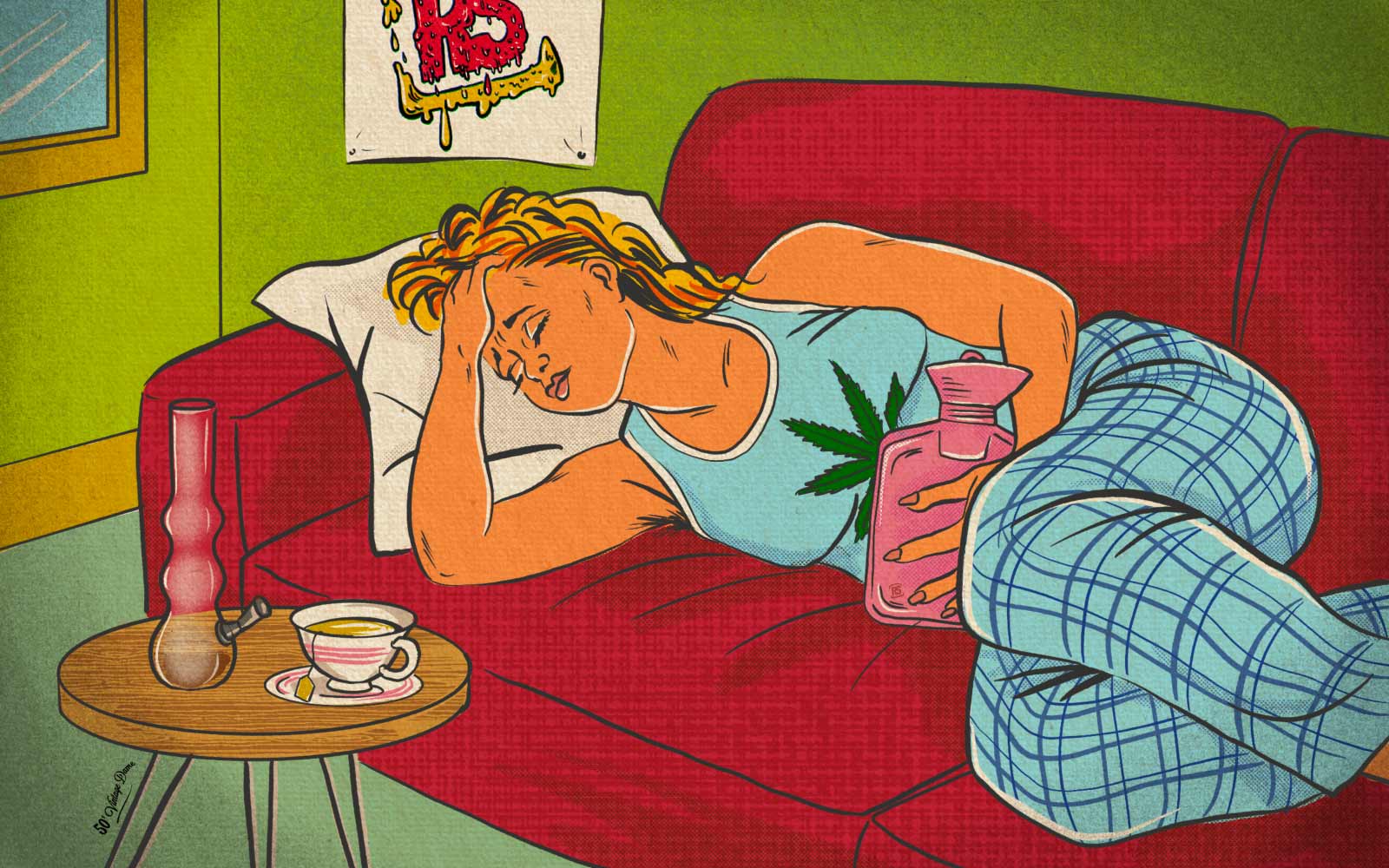Discussions about vaginas, uteruses and menstruation are regularly diminished as taboo, inappropriate and at worst disgusting. For people dealing with gynecological health concerns, the stigma surrounding their bodies’ natural functions can leave them managing challenging symptoms on their own. Some gynecological disorders, like endometriosis, leave medical professionals at a loss for how to best help the millions of people suffering. Could cannabis be the answer? Let’s explore endometriosis and cannabis and see if this medicinal plant can provide new hope.
History of Endometriosis
The struggle for informed reproductive care continues to be a burden for women in the doctor’s office. For women of color and trans-women, the disparities in care are even more extreme and potentially life-threatening. In order to better understand today’s landscape of reproductive healthcare, let’s look at how medical professionals handled endometriosis in the past.
The origins of endometriosis are unknown. As far back as 4,000 years ago, Egyptian hieroglyphs and paintings depict people experiencing painful endometriosis-like symptoms — sometimes referred to as “suffocated uterus.” In 400 BC, Hippocrates — the father of medicine — linked together with the symptoms of pain, infertility and menstrual dysfunction under the umbrella term: hysteria.
Simply put, hysteria is the belief that the complaints of physical symptoms exist only in the patient’s mind. For centuries people coming forward with menstrual or vaginal pain were demonized as nymphomaniacs, institutionalized or even killed.
Sigmund Freud helped popularize the diagnosis of hysteria in the 19th century. Rather than looking for the cause of pain, he insisted the sensations were all occurring in the patient’s mind and plugged the best course of treatment as psychoanalysis.
Today, doctors have updated terminology. Somatization is diagnosed when psychological distress presents itself as physical symptoms. Medical practitioners are up to ten times more likely to give female-presenting patients a somatization diagnosis.
What Is Endometriosis?
Endometriosis is an estrogen-dependent condition characterized by the growth of endometrial tissue — the tissue lining the uterus — in other areas of the body. Endometriosis usually occurs in the pelvis, commonly on the nearby fallopian tubes and ovaries. As monthly hormonal cycles fluctuate, the endometrial tissue grows in anticipation of fertilization, only to be shed during menstruation.
For people with endometriosis, the tissue growing outside of the uterus also builds up and sheds. Over time the shedding tissue becomes trapped, causing scarring, cysts and inflammation. Endometriosis affects up to 10% of biological females of reproductive age and is one of the most common gynecological diseases.
Medical practitioners diagnose endometriosis in stages based on the severity of tissue buildup and the presence of cysts. There are multiple types of endometriosis, depending on where the tissue attaches and the types of cystic scarring.
Though later stage endometriosis reduces chances of fertility, the severity of other symptoms does not depend on stage or type. Someone with early-stage endometriosis can experience more severe symptoms than someone with a later stage form.
Endometriosis can be incredibly painful. Not only do people experience painful menstruation, but patients report unpredictable, sometimes daily pain during sex, urination and bowel movements. Apart from pain, other symptoms are bloating, fatigue, nausea and increased risk for depression and anxiety.
The constant cycles of pain leave those with endometriosis desperate for relief and solutions, though doctors are still unsure how to best treat this disease.
Current Treatments Available
The current treatment options available focus on symptom management because medical research has not found a definitive solution.
Hormonal therapy works to stop the menstrual flow with the help of progestin and oral contraceptives, and a gonad stimulating hormone meant to reduce pelvic pain. Long-term hormonal treatment can create a hyperestrogenic environment related to mood instability, menopausal symptoms and bone loss.
For people wanting to conceive without the help of in vitro fertilization, hormone therapy lowers their chances of fertility. If a patient wants to undergo hormone therapy, they must do so before moving on to another option.
The other option is surgery, either minimal or extensive depending on the person’s desire to conceive without medical intervention. So far, extensive surgical intervention leads to the greatest reduction in pain. However, endometriosis can recur even after surgery.
Receiving an endometriosis diagnosis can be challenging. Without the presence of late-stage cysts, medical professionals are unable to diagnose without surgery. When attempting to obtain an endometriosis diagnosis, patients often find their pain deemed normal or even to be expected as menstruation is painful for over 80% of people with periods. The average patient takes 10 years to receive an endometriosis diagnosis.
Cannabis for Treatment
While researchers work to find more comprehensive solutions to this enigmatic disease, people continue dealing with tremendous amounts of pain. Could cannabis prove to be a possible solution?
Endometriosis has disastrous effects on a patient’s quality of life. Over time, chronic pain with no long-term sustainable solution takes an emotional toll. Research highlights cannabis as a helpful tool for other types of chronic pain management. The peripheral nerves interpreting painful stimuli are full of cannabinoid receptors.
Certain cannabinoids, like THC, block the peripheral nerve receptors hindering their communication with the brain. This presents as a reduction of pain. This connection is a promising indicator of cannabis’ effectiveness in treating pain related to endometriosis.
Spanish researchers are examining the link between endometriosis relief and THC specifically. By examining the effects of THC on mice with endometrial implants, they found that not only did THC reduce painful symptoms but over the course of the trial the endometrial implants shrunk in size. These findings inspired a clinical trial involving human participants launching later this year.
The lack of effective treatment leaves people with endometriosis on their own to figure out how to manage their symptoms. Outside of the clinical setting, cannabis is anecdotally life-changing.
Lara Parker, the author of Vagina Problems, speaks of how consuming cannabis and using cannabis products not only allows her to get through her days but genuinely enjoy her life.
For Lara, a primary symptom of her endometriosis is nausea and stomach swelling, making eating a challenge. Cannabis allows her enough relief to eat and a mental break from feeling nauseous.
For her sex life, before implementing cannabis-infused lubricant and suppositories, penetrative sex and orgasm were off the table because both only increased her abdominal pain. Sexual wellness is a cornerstone of holistic wellbeing and for people with endometriosis, cannabis can help them experience pleasurable solo or partnered sex.
Battling the Stigma
The only drawback of cannabis use for endometriosis is the stigma surrounding it. Stoner stereotypes paint a judgemental picture of people using cannabis daily for medicinal purposes. Menstruation comes with its own stigmatizations. Though it is a normal part of the reproductive process it is often hidden by euphemistic language and pink packaging.
Myths surrounding female reproductive function normalize experiences of pain. First time engaging in penetrative sex behaviors? Expect pain. Cramps while menstruating? That’s just part of having a period. Side effects from contraception methods? Deal with or risk the ultimate pain of childbirth. These narratives perpetuate the idea that pain is unavoidable and a normal part of reproductive function.
When asked to describe the pain of endometriosis people describe stabbing knives, scratching claws or a sensation as if their abdomen is on fire. Some say that on bad pain days they are unable to leave their beds, crawling to the bathroom to vomit and falling into spirals of depression as they contemplate grappling with this until menopause. The potential relief that cannabis provides is an invaluable resource in the journey towards treating this disease.
Psychonaut Thoughts
Do you or a loved one have any experience with cannabis and endometriosis? If you are comfortable we would love to hear your thoughts in the comments below.















